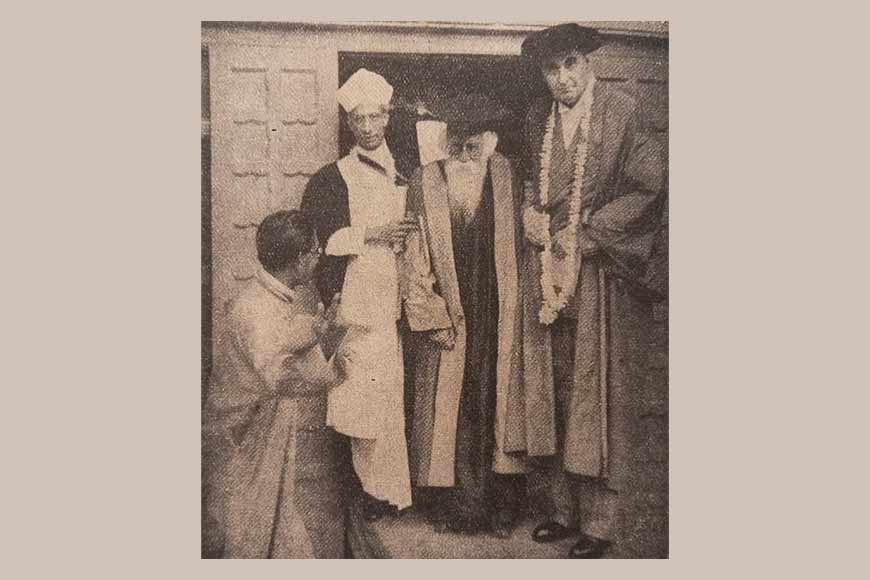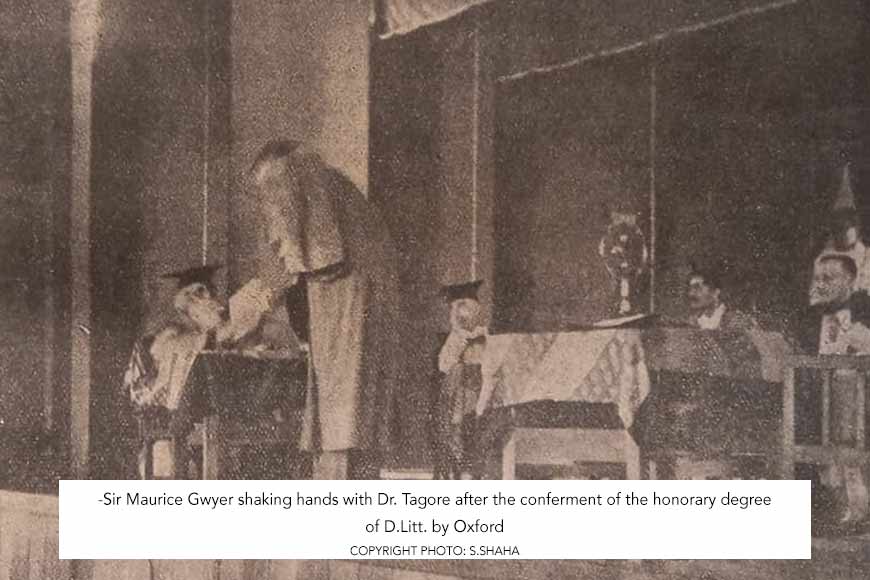When Oxford came to Santiniketan - GetBengal story

The Poet being conducted to the dais by Sir S. Radhakrishnan and Sir Maurice Gwyer at the Special Convocation of Oxford University at Santiniketan
On August 7, 1940, Great Britain’s renowned (and ancient) Oxford University broke a very important rule. For the first time in its history since 1096 AD when it was established, it arranged a special convocation in a distant land – a colonised land, moreover – to confer an honorary D’Litt (Doctor of Literature, Honoris Causa).
The distinguished gentleman who received the degree was, of course, Rabindranath Tagore. He was to pass away exactly a year later, and considering he was already a Nobel Laureate, an honorary doctorate from Oxford University may not seem like much. At the same time, it should be remembered that for a university as prestigious as Oxford, a special convocation is practically unheard of even today. And to further put the matter in perspective, the second such honoree was US President Franklin D. Roosevelt, in 1941.
“According to time honoured custom, the address was read out in Latin, an English translation of which was repeated to the audience by Sir S. Radhakrishnan. Dr. Tagore replied to the address in Sanskrit and himself rendered it into English for the benefit of the audience. Sir Maurice Gwyer, who presided over the function, wound up the proceedings with a brief address,” a contemporary report reads.

Today being Sir Sarvepalli Radhakrishnan’s birthday – celebrated as Teacher’s Day in India – it seems appropriate that he, along with Sir Maurice Gwyer, then Chief Justice of India, were both authorised to represent Oxford University at the special function held in Santiniketan’s famed Sinha Sadan.
It also seems appropriate to point out that Oxford University wasn’t merely honouring Tagore the man of letters. It was also honouring a teacher par excellence, the founder of a university which had already – despite being just about 20 years old in 1941 – begun to make a name for itself as a centre of excellence particularly for visual and performing arts.
Also read : The Tagorean vision which India forgot
Of course, there’s a great deal more to Tagores’s educational philosophy, discussed in the previous article in this series, but Visva-Bharati’s growing fame also bore testament to his abilities as a skillful administrator and logistics wizard, to add to his other incredible qualities.
All of which becomes even more mind-boggling when one considers that the man himself dropped out of school and college several times, and never even cleared the matriculation examination. Initially admitted to the then renowned Oriental Seminary School at the age of seven in 1868, he decided school was a place where students merely went to be punished and beaten with canes, dropping out only a month later.
In 1876, the family tried again, sending the 15-year-old to St Xavier’s School, where he spent six months before he left, though he seems to have had a slightly better time at St Xavier’s than at Oriental Seminary. In fact, Tagore actually presented a statue of Jesus Christ to the school in 1927.
To conclude our narrative, Tagore’s idea of education – and life– is perhaps best symbolised by the Rigvedic hymn which opened the special convocation at Santiniketan on that August day in 1941:
स्वस्ति पन्थामनुचरेम सूर्याचन्द्रमसाविव। पुनर्ददताध्नता जानता सं गमेमहि
(Like sun and moon we shall follow the path of welfare and attain companionship of men who are generous, hateless, and wise)
Source: Calcutta Municipal Corporation Gazette’s Tagore Memorial Special Supplement, published September 13, 1941











